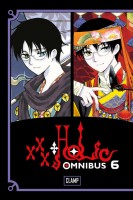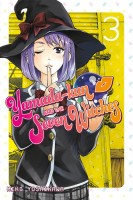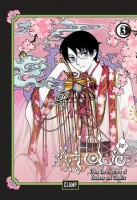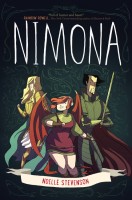My News and Reviews
Okay! In addition to the usual My Week in Manga feature, I managed to post three other things last week. First up was the announcement of the Sparkler Monthly Giveaway Winner, which also includes a list of the current, ongoing series being released in Sparkler Monthly (which is only a fraction of the total content). The other two posts were in-depth manga reviews; I took a look at a couple of Kodansha Comics’ recent releases. The first in-depth review of the month went to Naoshi Arakawa’s Your Lie in April, Volume 2, which I enjoyed. But then again, it’s a music manga, so it’s not too surprising that I like it. I also reviewed Masayuki Ishikawa’s Maria the Virgin Witch, Volume 3. It’s the last volume of the series, although the seque Exhibition is scheduled to be released in English later this year. Maria the Virgin Witch is somewhat uneven, but I still found it to be both intriguing and engaging.
As seems to always be the case nowadays, life was keeping me very busy last week, but I still came across some interesting things elsewhere online. A translation of an interview of Daisuke Igarashi, for example. Last week also marked the seventieth anniversary of the dropping of the atomic bombs on Hiroshima and Nagasaki by the United States. It’s quite timely then that Last Gasp launched a Kickstarter project to create a hardcover edition of Keiji Nakazawa’s Barefoot Gen with schools and libraries specifically in mind. To coincide with this, Paul Gravett reposted his article “Keiji Nakazawa: Barefoot in Hiroshima”. Barefoot Gen is a tremendous work. One of the Manga Moveable Feasts was even devoted to it back in the day. If anyone is interested in learning more about Nakazawa himself as well as some of the historical context surrounding Barefoot Gen, his autobiography was translated into English several years ago.
Quick Takes
 Prophecy, Volume 3 by Tetsuya Tsutsui. The first volume of Prophecy is the one that left the greatest impression on me, but in general it’s a very strong series. I didn’t find the second volume to be quite as compelling as the first, but the third provides a mostly satisfying conclusion to the series even though in some ways it felt a little anticlimactic. One of the members of Paperboy tips off the police and soon the Cyber Crimes Division has been able to identify the four terrorists. As the investigators draw closer and closer to capturing the men, they begin to notice what at first seem to be mistakes, slip ups, and inconsistencies in the group’s behavior. However, everything falls into place once Paperboy’s true motivations for committing all of the crimes are revealed. Prophecy is a realistic, smart, and engaging series with the added bite of social commentary. There’s apparently also a Prophecy spin-off series. I don’t think that it has been licensed, or that there are any current plans to do so, but I’d certainly be interested in reading it.
Prophecy, Volume 3 by Tetsuya Tsutsui. The first volume of Prophecy is the one that left the greatest impression on me, but in general it’s a very strong series. I didn’t find the second volume to be quite as compelling as the first, but the third provides a mostly satisfying conclusion to the series even though in some ways it felt a little anticlimactic. One of the members of Paperboy tips off the police and soon the Cyber Crimes Division has been able to identify the four terrorists. As the investigators draw closer and closer to capturing the men, they begin to notice what at first seem to be mistakes, slip ups, and inconsistencies in the group’s behavior. However, everything falls into place once Paperboy’s true motivations for committing all of the crimes are revealed. Prophecy is a realistic, smart, and engaging series with the added bite of social commentary. There’s apparently also a Prophecy spin-off series. I don’t think that it has been licensed, or that there are any current plans to do so, but I’d certainly be interested in reading it.
 xxxHolic, Omnibus 6 (equivalent to Volumes 16-17) by CLAMP. For the most part I have been enjoying xxxHolic since the beginning of the series, but I think this omnibus has been my favorite so far. I really liked its brooding, ominous atmosphere. The humor that was so prevalent earlier in the series is actually almost entirely gone. The comedy in xxxHolic could be fun, but I have a particular penchant for the series’ supernatural angst, and that’s definitely taken the forefront in the last few volumes. I also initially found the crossover between Tsubasa: Reservoir Chronicle and xxxHolic to be intriguing, but I’ll admit that I was happy to see that the other series didn’t intrude too much in this omnibus. Instead, xxxHolic is focusing on how Watanuki and the others are coping now that Yuko is gone. Watanuki takes it especially hard and his tendency to slip in and out of dreams is becoming increasingly dangerous. There’s not much that the people who care about him can actually do except to watch over and support him as best as they can.
xxxHolic, Omnibus 6 (equivalent to Volumes 16-17) by CLAMP. For the most part I have been enjoying xxxHolic since the beginning of the series, but I think this omnibus has been my favorite so far. I really liked its brooding, ominous atmosphere. The humor that was so prevalent earlier in the series is actually almost entirely gone. The comedy in xxxHolic could be fun, but I have a particular penchant for the series’ supernatural angst, and that’s definitely taken the forefront in the last few volumes. I also initially found the crossover between Tsubasa: Reservoir Chronicle and xxxHolic to be intriguing, but I’ll admit that I was happy to see that the other series didn’t intrude too much in this omnibus. Instead, xxxHolic is focusing on how Watanuki and the others are coping now that Yuko is gone. Watanuki takes it especially hard and his tendency to slip in and out of dreams is becoming increasingly dangerous. There’s not much that the people who care about him can actually do except to watch over and support him as best as they can.
 Yamada-kun and the Seven Witches, Volume 3 by Miki Yoshikawa. There really are witches in this series! With its good-natured comedy and gender play, I’ve liked Yamada-kun and the Seven Witches a great deal from the very start. But with the third volume, Yoshikawa has started to really develop the series’ worldbuilding and is diving even further into the details of how the magic works. The relationships between the characters are also becoming more fleshed-out and complicated, which I’m enjoying as well. One of the things that I particularly appreciate about the series is that it seems perfectly okay for a guy to be crushing on another guy. Yes, it’s because there are some strange supernatural powers at work, but it’s also not treated like something gross. The setup also allows kissing to freely occur regardless of gender, which is fun. There’s still plenty of fanservice in Yamada-kun and the Seven Witches, as one would probably expect from a shounen series full of gender- and body-swapping, but I generally find it to be tastefully done.
Yamada-kun and the Seven Witches, Volume 3 by Miki Yoshikawa. There really are witches in this series! With its good-natured comedy and gender play, I’ve liked Yamada-kun and the Seven Witches a great deal from the very start. But with the third volume, Yoshikawa has started to really develop the series’ worldbuilding and is diving even further into the details of how the magic works. The relationships between the characters are also becoming more fleshed-out and complicated, which I’m enjoying as well. One of the things that I particularly appreciate about the series is that it seems perfectly okay for a guy to be crushing on another guy. Yes, it’s because there are some strange supernatural powers at work, but it’s also not treated like something gross. The setup also allows kissing to freely occur regardless of gender, which is fun. There’s still plenty of fanservice in Yamada-kun and the Seven Witches, as one would probably expect from a shounen series full of gender- and body-swapping, but I generally find it to be tastefully done.














